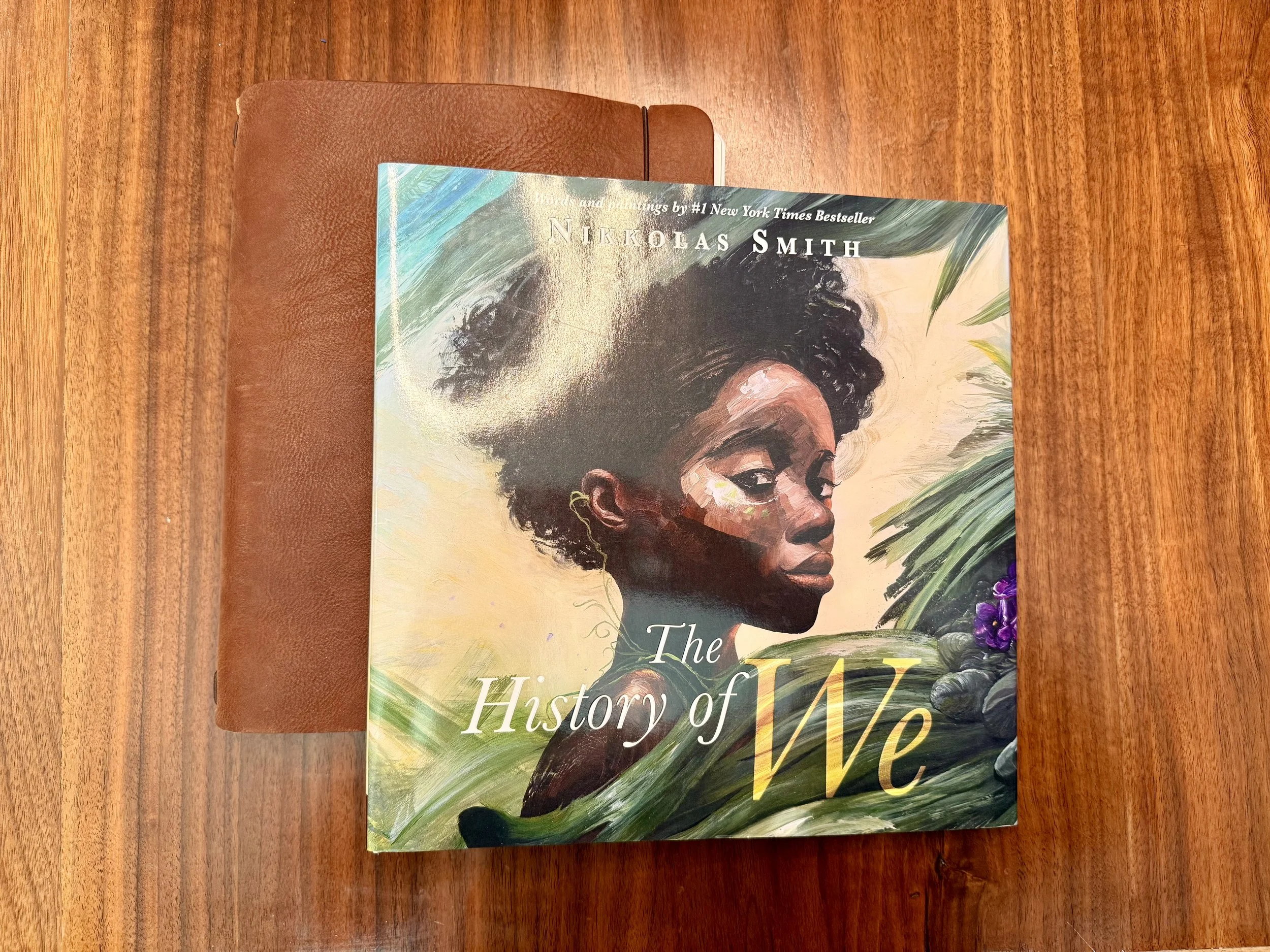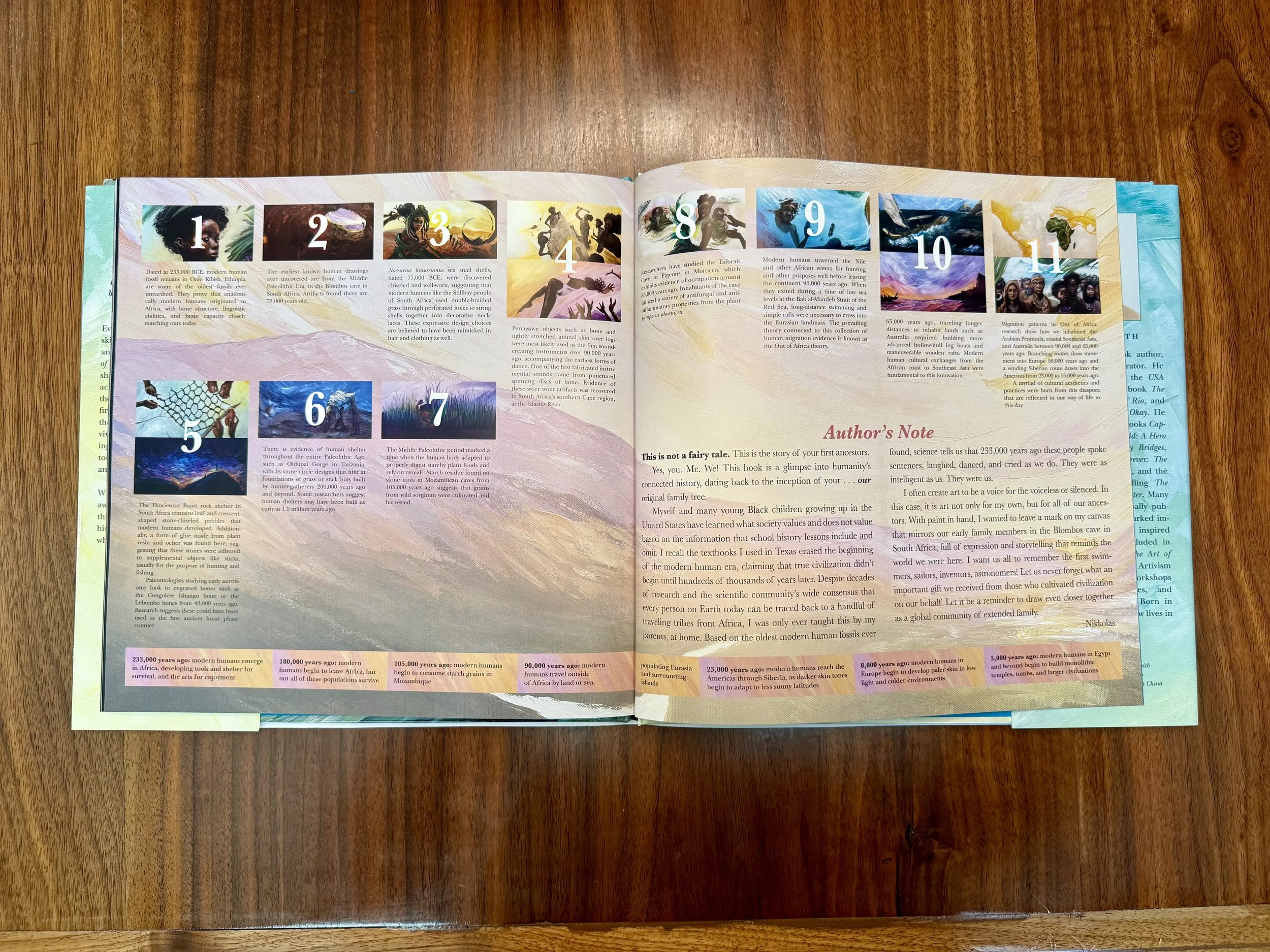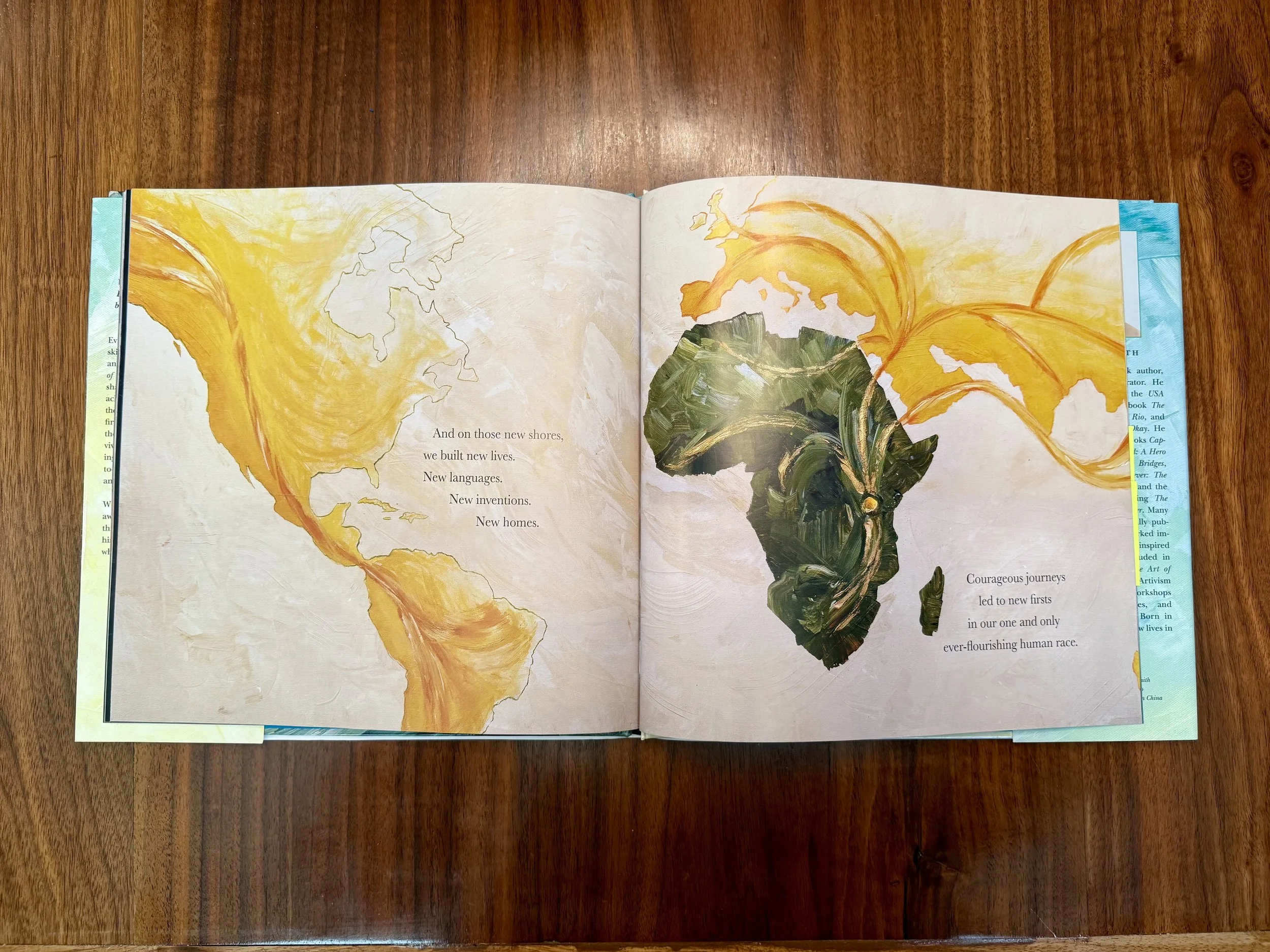The History of We: Journaling with Legacy, Connection, and Hope
Disclosure: Writing Mindset only endorses things that I’ve personally used, something similar, or come highly recommended by trusted peers. If you grab anything I mention using a referral link, I may get a small commission. However, there’s no extra cost to you. If you would like to learn more, please visit the privacy policy and disclosure page.
Nikkolas Smith’s The History of We is a breathtaking picture book that explores humanity’s collective story from our earliest beginnings to the present moment and our shared responsibility to create a more compassionate world. Through his poetic text and powerful illustrations, Smith shows how we are all part of something bigger: a global community bound by love, struggle, and hope.
For writers, The History of We offers a reminder that personal stories connect to a much larger narrative. For journalers, it’s an invitation to reflect on identity, ancestry, and legacy—to ask: Where do I come from? What stories do I carry? What part of the “we” am I helping to write? It is also a picture book with a strong reminder about the danger of single stories. On how we can avoid making generalizations and assumptions in order to really take the time to get to know the multiple points of views that exist within a community, culture, and world around us.
In this post, you can find…
Tips for using this book as a mentor text for writing
Ways to use the book with preschoolers, grades k-5, grades 6-8, grades 9-12, and for disciplinary literacy projects
Journaling prompts linked to the book (including nature journaling)
One grammar exercise to access grammar instruction
Using The History of We as a Mentor Text
This book was chosen because it blends historical narrative with a personal and emotional perspective, demonstrating how writers can tackle complex social topics while maintaining accessibility for younger audiences. Its lyrical language, paired with compelling illustrations, makes it a strong example for teaching voice, perspective, and social commentary in both creative and informational writing.
When reading Smith’s book, notice how he:
Uses rhythm and repetition – Phrases build momentum and emotion, reinforcing unity and connection.
Blends personal and collective identity – “I” and “we” are woven together, showing how individual experiences form a shared human story.
Centers love and empathy – Even through pain and history, hope remains the heartbeat of the text.
Pairs imagery with emotion – The illustrations deepen the message, showing the past, present, and future as one continuous thread.
As a mentor text, The History of We encourages writers to see how language can build bridges—between generations, cultures, and hearts.
Journaling Prompt: “The Story of Us”
Open your journal and explore the idea of connection and belonging. Try one of these approaches:
Write about a tradition, story, or moment that connects you to your family, community, or culture.
Reflect on a shared experience—something your “we” (family, friends, classroom, or group) has gone through together.
Write from the perspective of the collective voice: We are dreamers. We are builders. We are keepers of stories.
Use repetition to create rhythm and power, echoing Smith’s style:
We remember. We rise. We keep building the world we need.
Why This Works
Writing collectively helps us think beyond the self. It reminds us that while our experiences are unique, they’re also deeply connected to others. The History of We offers a framework for gratitude, empathy, and understanding—values that come alive when we write about who we are together.
👉 Try it today: Begin a journal entry with “We are…” and let the rest unfold as a meditation on connection, resilience, and shared humanity.
For Educators: Bringing The History of We into the Classroom
Preschool Literacy Connections
This book can help young learners explore belonging and empathy through stories and images.
Discuss what it means to work together, help others, or share kindness.
Invite children to draw pictures of their “we” (family, friends, or class) and label them: We play. We share. We care.
Use repeated sentence stems to build literacy and confidence: We are friends. We are helpers. We are artists.
Grades K–5
Elementary students can use The History of We to explore both community and diversity.
Create a class poem beginning with “We are…” lines contributed by each student.
Discuss how differences make the “we” stronger.
Incorporate social studies connections—map where students’ families come from and write a “We come from…” poem.
Tie in art by illustrating their collective poem as a mural or collaborative collage.
Grades 6–8
For middle schoolers, this book sparks meaningful conversations about history, identity, and empathy.
After reading, have students reflect: What does it mean to belong?
Use journaling to connect personal history to larger themes—migration, change, courage, and justice.
Encourage students to write a short narrative or poem from a plural perspective: We marched. We dreamed. We became.
Pair this activity with classroom discussions about teamwork, leadership, and community responsibility.
Grades 9–12
High school students can approach The History of We through the lens of voice, history, and social justice.
Analyze Smith’s structure—how repetition and imagery create rhythm and tone.
Pair with other texts about collective identity or activism, such as Langston Hughes’s “I, Too” or Amanda Gorman’s “The Hill We Climb.”
Have students write their own “History of We” poem representing their generation’s hopes or challenges.
Invite performance or visual interpretations—spoken word, short film, or illustrated anthology entries.
Disciplinary Literacy Connections
The History of We connects beautifully across content areas:
Social Studies: Explore personal and collective history through storytelling or family timelines.
Science: Reflect on the interconnectedness of ecosystems—how “we” includes all living things.
Art: Create a visual timeline of human cooperation and creativity inspired by Smith’s illustrations.
Math: Investigate how patterns and symmetry mirror unity and balance in design—then write a short reflection: We are numbers adding up to something greater.
Each activity deepens understanding of how collaboration, creativity, and connection form the foundation of learning.
Example Assignments
One of the things I always say about this book is to highlight the teaching moments located in the back of the text. All books should have this, whether fiction or nonfiction, because it provides accessible teaching opportunities in the classroom and helps build prior knowledge and connections to historical topics. This book also naturally connects to two other resources already located on the blog:
Both of these assignments provide opportunities to build classroom community and a shared sense of “we.” However, Your-Life-At-A-Glance also offers insight into personal history. While the assignment uses personal history as a lens for creating a claim and argument, it can also serve as a way to explore, build, and share a sense of collective history in the classroom. The History of We serves as an excellent inciting text to launch the project.
Grammar Focus: Sentence-Level Craft
Skill Focus: Parallel Structure for Emphasis and Unity
Smith’s writing uses repetition and balance to create rhythm and cohesion. Teach students (or yourself) to build strength through parallel phrasing:
We remember our roots. We honor our stories. We plant new seeds.
We have struggled. We have healed. We keep moving forward.
Parallel structure emphasizes equality and shared purpose—perfect for reflective or poetic journaling.
Nature Journaling Connection
The illustrations in The History of We show Earth’s natural beauty intertwined with human history. Take inspiration from this by connecting environment and humanity in your journal.
Observe nature and reflect: What connects us to the land?
Write a short “We are” poem inspired by natural cycles—We are rivers. We are trees. We are wind and flame.
Explore how natural imagery mirrors human growth, resilience, and renewal.
Additional Journal Prompts for Wellness
The theme of connection extends naturally into wellness and gratitude journaling. Try these prompts:
“Who is part of my ‘we’—the people who support and shape me?”
“What shared experiences bring me joy or healing?”
“How can I contribute to the ‘we’—to my community or classroom—in a meaningful way?”
“What does belonging feel like in my body, heart, and mind?”
These prompts encourage emotional awareness and collective empathy, helping writers see themselves as part of something larger.
Final Thought:
The History of We reminds us that our stories are intertwined—each life a note in a larger song. Through reflection, writing, and creative practice, we can help students (and ourselves) see the beauty of belonging and the strength in unity. Every “we” begins with one small act of noticing, caring, and writing it down.







